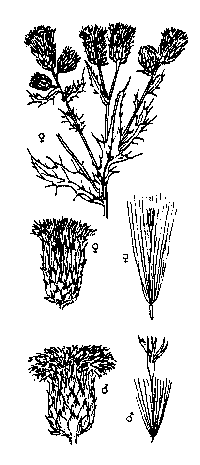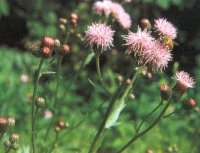|
Cirsium arvense
|
|
|
|
Scientific name
|
Cirsium arvense
|
|
Additional name information:
|
(L.) Scop.
|
|
Common name
|
Canada thistle, California thistle, creeping thistle, corn thistle, perennial thistle, field thistle
|
|
Synonymous scientific names
|
Cirsium lanatum, Serratula arvense
|
|
Closely related California natives
|
20
|
|
Closely related California non-natives:
|
3
|
|
Listed
|
CalEPPC List B,CDFA B
|
|
By:
|
David Bayer
|
|
Distribution
|
|
HOW DO I RECOGNIZE IT?
Distinctive features:
|
Canada thistle (Cirsium arvense) is
a persistent perennial thistle that grows vigorously, forming dense colonies and
spreading by roots growing horizontally that give rise to aerial shoots. Plants
generally grow one to four feet tall, but on occasion may grow more than six
feet tall and branch freely. Stems are smooth, mostly without spiny wings, green
and glabrous. Flower heads are numerous, small, and almost spineless. Flowers
are purplish lavender or, less commonly, white.
|
|
Description:
|
| Asteraceae. Perennial, vigorous plant that spreads by horizontally growing root stalks. Stems: smooth, mostly without spiny wings, green and glabrous. Plants 1-4 ft (30-120 cm) tall with green foliage. Leaves: alternate, margins variable from entire to deeply lobed, 2-8 in (5-20 cm) in length, sessile, slightly clasping or shortly decurrent. Spines along margins of leaf 1/8-3/8 in (3-5 mm) in length. Inflorescence: flowerheads small, 0.4-1 in (1-2.5 cm) diameter and approximately 1 in (2.5 cm) tall, rounded or flat-topped; involucre hemispheric to ovoid, outer phyllaries ovate, tipped with stout spines 1/16 in (1 mm), inner phyllaries progressively longer with tips flattened. Flowers: plants dioecious with all flowerheads either pistillate (female) or staminate (male). Florets all tubular, generally purplish lavender to, less commonly, white. |
|
Staminate flowers (male) with corolla 1/2
in (12-13 mm) long, tube 1/3 in (8 mm) and lobes 1/8 in (3-4 mm). Pistillate
flowers (female) with corolla 3/5-3/4 in (14-20 mm) long, tube 3/8-5/8 in (10-16
mm), and lobes 1/16-1/8 in (2-3 mm). Pappus abundant, white, feathery
(branched), to 3/4-1 3/4 in (20-30 mm) long and fragile, easily broken off at
the achene. Fruits: achenes light brown, approximately 1/8 in (3 mm) long,
slightly grooved along long axis, flattened, and occasionally curved. There is
an inconspicuous yellow rim at the apex where the pappus joins the seed with a
small conical point in the center. Base of seed slightly rounded (Hickman
1993).
åÊ
|
|
WHERE WOULD I FIND IT?
|
Canada thistle is common throughout
northern California, including the Sierra Nevada, Modoc Plateau, Central Valley,
Coast Range, and San Francisco Bay Area. Although less vigorous in southern
California, it has been found along the coast as far south as
Orange and Riverside counties. Inland it is also known to
occur in Kern County and in montane areas of Fresno, Inyo, and Mono
counties (Barbe 1990). The southern distribution is probably limited by high
temperatures.
Canada thistle grows on a variety of soil types. It does well on
deep, well aerated, moist loam soils, but is known to grow in dry habitats and
on sandy soils. It may also grow on stream banks, in meadows, and even in wet
ditches, but it will not survive in saturated soil. It is intolerant of shade,
requiring good light conditions for aggressive growth (Moore 1975, White et al.
1993).
Canada thistle infests many habitats such as cultivated fields,
roadsides, pastures and rangeland, railway embankments, and lawns. It is a major
pest in streamside grasslands from the Pacific Northwest eastward to the plains.
It also invades moist prairies.
|
|
WHERE DID IT COME FROM AND HOW IS IT SPREAD?
|
Canada thistle is native to southeastern Europe and the eastern
Mediterranean area. It has spread to most temperate parts of the world and is
considered an important weed in thirty-seven countries (Parsons 1992). It is
particularly troublesome in cooler areas of North America, extending from coast
to coast in both Canada and the United States. It was introduced into North
America in the seventeenth century by French settlers as a contaminant in crop
seed (Moore 1975). It was probably introduced into California the same
way.
Canada thistle spreads by seed, either by wind or as a
contaminant in crop seed. The pappus is fragile and easily separated from the
seed, so most seeds stay in the vicinity of parent plants. The seeds float and
are easily distributed by water. Seeds can be spread in mud attached to farm
equipment. Infested packing material has also contributed to its
spread.
Once established, Canada thistle spreads rapidly by horizontal
roots, up to several meters per year. The extensive horizontal root system
assures long-term persistence and spread by vegetative means. A segment of root
as small as 1/8 to 3/8 inch (3-6 mm) in length and 1/16 inch (1 mm) in diameter
is able to propagate a new plant and is easily spread with plant material or by
equipment (Rogers 1928, White 1979).
|
|
WHAT PROBLEMS DOES IT CAUSE?
|
Canada thistle is considered a noxious weed
in California, and in many states it is considered one of the most serious pests
to agriculture. In North America heavy infestations reduce yields of spring
cereals by 40 to 70 percent. Canada thistle occurs on 40 percent of cultivated
lands of the Canadian prairie provinces, and loss of wheat in Saskatchewan alone
was estimated to be worth $4 million in 1980. Approximately one million hectares
of grassland are infested in England and Wales (Parsons 1992). Once established,
Canada thistle is a fierce competitor for nutrients and water needed by crops or
native plants. It produces allelopathic chemicals that assist in displacing
competing plant species (Stachion and Zimdahl 1980). It has been reported to
accumulate nitrates that cause poisoning in animals (Fuller and McClintock
1986). The spiny leaves scratch animal skin, sometimes causing infection, or, at
a minimum, restrict animal grazing in heavily infested areas (Moore
1975).
|
|
HOW DOES IT GROW AND REPRODUCE?
|
In established plants of Canada thistle, carbohydrates move from the root system up to the newly forming shoots as growth starts in spring. As leaves on the shoots develop, photosynthates start moving to newly developing roots and flowerheads. The developing flowerheads take more and more of the energy (photosynthates) produced by the leafy stems and stored in the roots. Carbohydrates in the root system are at their lowest when the plant begins flowering. As seeds develop, photosynthates start moving down into the root system again and, after the seed reaches maturity, carbohydrate movement to the root system continues until frost kills the foliage.
|
Canada thistle typically flowers from late June through August. Male and female flowers are borne on separate plants. Seed production thus depends on having both male and female plants present within 330 feet (100 m) of each other, which often requires at least two introductions. It is rare to find a clone of Canada thistle that has both female and male parts in the same flower or that produces more than the occasional apomictic seed (Hodgson 1964, 1968).
|
(click on photos to view larger image)
|
Pollination is almost exclusively by insects. Male and female plants growing in close proximity result in high rates of seed production, with some plants producing over 5,000 seeds per plant. Viable seeds are formed eight to ten days following pollination. Seeds mature in late summer or early fall. They may germinate immediately after falling from the plant if conditions are favorable, or they may remain dormant in the soil for up to twenty-one years (Detmers 1927, Moore 1975, Lalonde and Roitberg 1994). Seeds that germinate immediately form a rosette that overwinters and flowers the
following summer. However, germination of most seeds is delayed until spring (Moore 1975). Approximately 90 percent of seeds germinate within one year. Some seeds remain dormant in the soil for several years. Viability is a function of age of seed and depth in the soil. The deeper the seed is buried, the longer the viability. Ideal conditions for germination are abundant soil moisture and temperatures averaging 20 to 30 degrees C (White 1979). Seedling survival is
poor. Seedlings do not establish in areas with existing groundcover and survive only on disturbed or bare areas in unshaded situations (Parsons 1992). Seedlings develop rapidly, first developing a taproot. Approximately six to eight weeks later, plants develop lateral roots that grow more-or-less horizontally. These lateral roots last approximately two years before they die and disintegrate. In the meantime, they produce new shoots and plants, resulting in a clonal infestation that spreads outward rapidly, approaching twenty feet (6 m) in a single season (Donald 1990). Despite the taproot, over half of the root system grows in the top twelve inches (30 cm) of soil. Roots go much deeper than that,
however, with some vertical roots penetrating fifteen to twenty feet (5-7 m) deep (Haderlie et al. 1987). New plants readily emerge from small root fragments. Shoots can emerge from root fragments at a depth of at least twenty inches (50 cm). Within two years, plants can produce over sixty-six feet (20 m) of new roots (Parsons 1992). Growth is prolific, and patches exist with 130 shoots per square meter.
|
|
HOW CAN I GET RID OF IT?
|
The most effective method of control
depends on the site, the extent of the infestation, the presence or absence of
both male and female flowering plants, growth characteristics of the plant, and
the impact of the control method on non-target species. The many ecotypes
respond differently to control measures. There is no easy method of control, and
all methods require follow-up. Combinations of mechanical, cultural, and
chemical methods are more effective than any single method used alone (Trumble
and Kok, 1982).
Regardless of the method or methods selected, competition from
other plants should always be considered in the control program. Because of the
longevity of viable seeds in the seedbank and the short time from germination to
perennation, monitoring of control sites to locate and eliminate new seedlings
and resprouts is essential. The site should be monitored at least twice a year
for the first four years, and should follow rain or irrigation by a month to six
weeks. Monitoring should be more frequent at the beginning of a control program
and can become less frequent with time.
|
|
Physical control:
|
Mechanical methods: Cultivation is not
generally recommended unless it is carried out with care and persistence,
because it often increases the problem by spreading root fragments to new
locations. Repeated cultivation at regular intervals of twenty days is effective
in exhausting the remaining root fragments but does not kill ungerminated seeds.
Care needs to be taken not to remove or disturb other desired native plants in
the area. Cultivation must start as soon as the plants first emerge in late
winter. Shallow cultivation in hot, dry weather is best.
Repeated mowing at three-week intervals will weaken the plant,
prevent flowering, and seed production, and generally can be timed to avoid
major impacts on desirable plants growing in the infested area.
Prescribed burning: Repeat burning has shown some reduction in
old, established stands of Canada thistle, but overall control generally is less
than satisfactory. Removal of old plant residue resulting from fire may promote
earlier seed germination of native species (Olson,
1975).
|
|
Biological control:
|
Insects and fungi: There are no effective biological control
organisms available at this time. There are several insects, such as Cassida
rubiginosa, Cleonus piger, Orellia ruficauda, and Vanessa cardui, that feed on
Canada thistle and cause some damage, but none effectively control Canada
thistle populations (Moore 1975, Maw 1976). O. ruficauda has been reported to be
the most effective. The rust species Puccinia obtegens has shown some promise
for controlling Canada thistle, but it must be used in conjunction with other
control measures to be effective (Turner et al. 1980).
Grazing: Sheep and cattle graze on Canada thistle when the
plants are young and tender, helping to deplete the root reserves. Recent New
Zealand studies show that goat grazing can be effective. Grazing and trampling
can increase stress on plants, enhancing the effectiveness of other control
measures such as herbicides. Livestock tend to avoid grazing in and around dense
patches of older plants. If young sheep eat older plants, their tender mouth
parts may be damaged by the spines and become infected (Parsons 1992).
Plant
competition: Vigorous competition from native plants is essential in achieving
lasting control.
|
|
Chemical control:
|
Chemical control should be used cautiously and in strict
compliance with the label, realizing that some non-target plant species may be
killed or seriously affected by the herbicide. Herbicides applied to the foliage
will enter the plant and be translocated or move with water in the transpiration
stream. Those herbicides that land on the soil may be taken up by the roots and
transported in the plant by water in the transpiration stream. Herbicide use
must be timed to the growth stage and physiology of Canada thistle (Tworkoski,
1992) and is most effective when used in combination with competition from other
plants. Thorough coverage of all foliage of an infestation (clones) is essential
because all shoots from infestations over two years old may not be
interconnected. Properly timed repeat applications of selected herbicides will
always be necessary to achieve complete control of Canada thistle. Applications
may be made either in spring or in fall, but fall applications have provided the
most control from a single application.
Glyphosate is a non-selective foliar applied herbicide that will
kill or seriously injure all growing vegetation with which it comes in contact.
Once it penetrates a plant, it is transported efficiently from cell to cell. It
has little or no soil residual except on light, sandy soil low in organic
matter. Applications should be made soon after flowering when photosynthates are
moving from the foliage to the roots. When the first application is properly
timed, extensive injury will occur to the developing root system. A second
application or another herbicide will be necessary to kill the crown and new
shoots arising from old roots that were not affected by the first
application.
Triclopyr, dicamba, and 2,4-D are all foliar-applied herbicides
that may seriously affect grasses and other monocots as well as many dicotyledon
plants. Like glyphosate, they are efficiently transported from cell to cell once
they enter the plantÛªs tissue. They all have some soil residual, but dicamba has
the longest (up to six months). Application should be made when Canada thistle
is actively growing and when photosynthates are being translocated from leaves
to roots.
Clopyralid or clopyralid + 2,4-D has shown good control of
Canada thistle where the root system has been disturbed. These herbicides are
foliar applied and generally have a soil residual of one to two months. Repeat
applications for two to four years generally have provided complete elimination
of established root systems. Caution should be exercised because many broadleaf
plants may be injured. Clopyralid leaches readily, especially in open sandy
soil.
|




